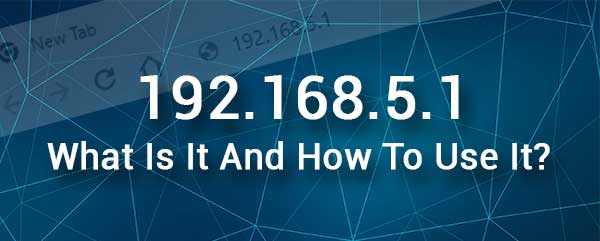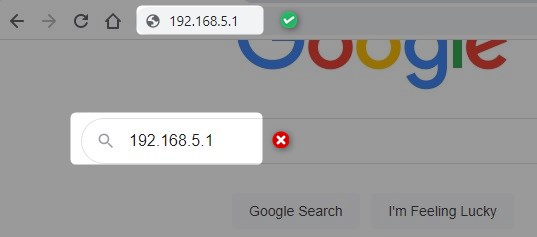If you are searching for more information about the IP address 192.168.5.1 it is possible that your router or one of the devices connected to your network has this IP assigned to it. In case you are wondering what 192.168.5.1 is and how you can use it, this article is for you.
In the next few paragraphs, we are going to tell you more about this IP address and also provide a troubleshooting guide in case it doesn’t work as it should.

CONTENTS
What Is 192.168.5.1?
We can say that the IP address 192.168.5.1 is both a private IP and a default one. But what does this actually mean?
This particular IP address belongs to the so-called Class C range of private IP addresses that goes from 192.168.0.0. to 192.168.255.255. As a private IP address, it can’t be accessed from the internet. Instead, it can be found and accessed within a network.

The good thing here is that as a private IP it can exist in as many networks as possible, but only once in the same network. In case two different devices in the same network get this IP, you can run into an IP conflict which will make your network unstable.
Therefore, if you want to manually assign an IP to a specific device, always check whether this IP is already assigned automatically.
A default IP on the other hand is the one the router manufacturer assigns in the factory. It can be then used to access the router settings, but the problem is that all the routers from that manufacturer have this IP set as a default one.
If you want, you can change it. It should add another layer of security to your network. This applies to all the default settings, it is recommended to change them as soon as possible.
How To Use 192.168.5.1 Properly?
You can use this IP address when you want to set up your wireless router, or when you want to make some configuration changes that will boost your network security, set up Parental controls, create a Guest network, or something else.
Here is a brief description of how to use the IP address 192.168.5.1 properly.
1. Get your computer or smartphone and connect it to your network. It is important that the device you are using and the router are connected to the same network. In case you don’t connect the device or you connect it to a different wireless network, you won’t be able to continue.
Based on the device you are using, you can either connect it over WiFi or use an Ethernet cable to connect the device and the router directly.
2. Open the web browser on your device and type the router’s IP address in the URL bar.

The router’s IP address can be found printed on a label on the router and in the user’s manual. You can also find it by yourself, just read our step-by-step guide on how to find the router IP address.
After you type the IP address, press Enter or Go. If the IP address is correct, you should see the router login page.
3. In the router login page you should enter the admin username and password. These can be also found printed on the router label, in the user’s manual. In most cases, you can find them on the router manufacturer’s official website.
After you type these login details into the required fields, click on the Login button and you should see the router admin dashboard.
4. Now you can customize the router settings just the way you like. You will see that the settings are well organized and you will be able to find the settings you want to change in a matter of seconds.
What To Do If 192.168.5.1 Doesn’t Work?
So, you follow the router login details closely and at some point, you receive an error message or a blank page and can’t continue. Well, not all the reasons are closely connected to the IP address 192.168.5.1, so here we will try to cover most of them and provide solutions that should help you access the router admin dashboard successfully.
Check whether the device is connected to the network. Either Airplane mode is enabled, the device is connected to the wrong WiFi network, or the WiFi switch has been pressed accidentally and WiFi is disabled.
If you have connected the device using a wired connection, check whether the connections are loose or whether you have plugged the Ethernet cable into the right port.
Type the IP address 192.168.5.1 into the URL bar. Sometimes people type it into the Search bar, and this is wrong.

Type the IP carefully. Mistyping the numbers is a common mistake, so pay attention. Also, always type digits when you type the IP address. It is not OK to type letters that look like the numbers 1 and 0, or to type 192.168.1.5 instead of 192.168.5.1.
Is 192.168.5.1 the correct router IP address? Follow this guide and find your router IP. Try to login again if the IP you have just found is different.
If you see a message saying something about the SSL certificate, click on Advanced at the bottom of the page and then click on “Proceed to 192.168.5.1” or “Accept the risk and Continue”.
Check the admin username and password. These can be found printed on the router label, in the user’s manual, or on the manufacturer’s website.
Type the admin username and password carefully. Pay attention to the Autocorrect feature if you are typing it on your smartphone or tablet.
Do you use a popup blocker on your browser? Disable it and try again. You can also disable the firewall and the antivirus software because they are probably blocking your attempts to access the router settings.
Contact your ISP support if you are still having trouble accessing the router settings.
Recommended reading:
- Does An IP Address Change With Wi-Fi?
- How to Find Router IP Address on Android?
- 127.0.0.1 – Localhost Address
Conclusion
192.168.5.1 is nothing different from the other IP addresses within the private IP range. If your router uses this IP address you can easily access its admin dashboard with the help of this IP. And for most users, this is just enough.
All you need to know then are the correct admin username and password and you will have full admin rights to configure the router settings just the way you want. And if something goes wrong, our troubleshooting section should be enough to help you fix the problem.

Hey, I’m David. I’ve been working as a wireless network engineer and a network administrator for 15 years. During my studies, I also worked as an ISP field technician – that’s when I met Jeremy.
I hold a bachelor’s degree in network engineering and a master’s degree in computer science and engineering. I’m also a Cisco-certified service provider.
In my professional career, I worked for router/modem manufacturers and internet providers. I like to think that I’m good at explaining network-related issues in simple terms. That’s exactly what I’m doing on this website – I’m making simple and easy-to-follow guides on how to install, set up, and troubleshoot your networking hardware. I also review new network equipment – modems, gateways, switches, routers, extenders, mesh systems, cables, etc.
My goal is to help regular users with their everyday network issues, educate them, and make them less scared of their equipment. In my articles, you can find tips on what to look for when buying new networking hardware, and how to adjust your network settings to get the most out of your wi-fi.
Since my work is closely related to computers, servers, and other network equipment, I like to spend most of my spare time outdoors. When I want to blow off some steam, I like to ride my bike. I also love hiking and swimming. When I need to calm down and clear my mind, my go-to activity is fishing.
